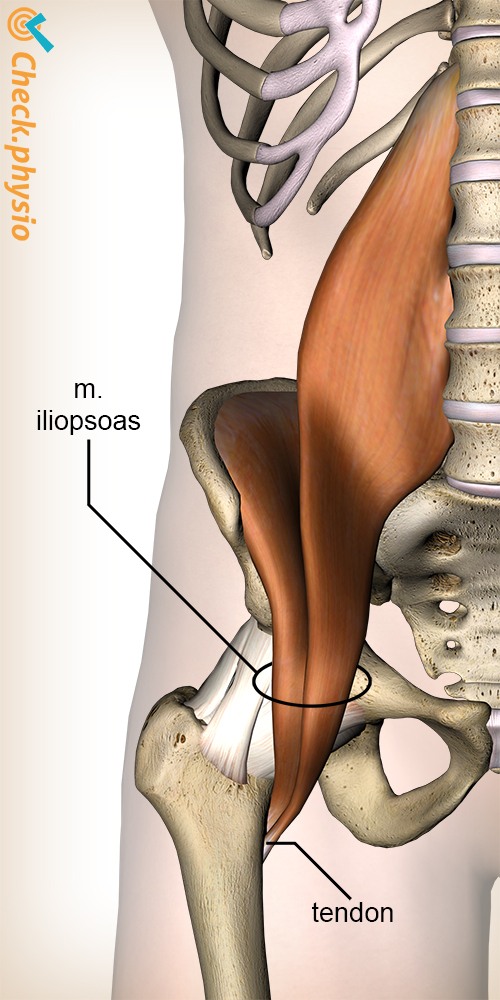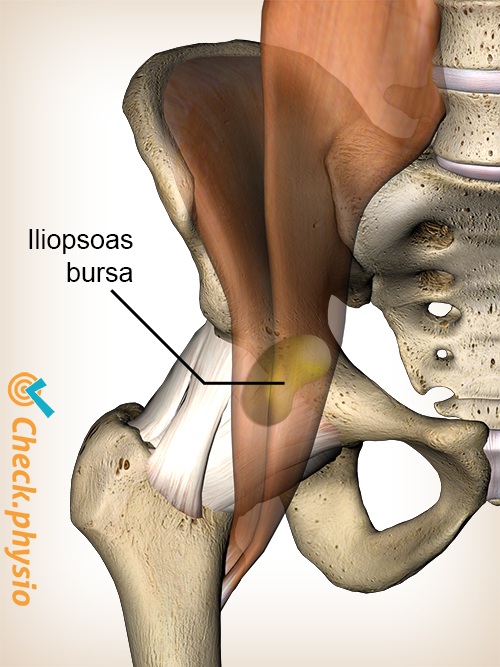- Conditions
- Iliopsoas syndrome
Iliopsoas syndrome Iliopsoas bursitis / iliopsoas tendinitis
Introduction
In the case of iliopsoas syndrome, the bursa and/or tendon of the iliopsoas muscle is affected. This results in pain along the front of the hip, in the groin region. Iliopsoas syndrome is often not recognised as a cause of hip pain.
The iliopsoas is the muscle that flexes the hip joint and rotates the thigh outwards. The iliopsoas attaches to the thigh bone (femur) via the tendon. The bursa located beneath the muscle ensures that everything slides smoothly and prevents friction. The bursa is approximately 5 to 7 cm long and 2 to 4 cm wide.

Description of the condition
Iliopsoas syndrome, refers to bursitis or tendinitis. This means that the bursa or the tendon is inflamed. They can also be inflamed simultaneously. The presentation of symptoms of iliopsoas bursitis and iliopsoas tendinitis are virtually identical. This justifies the combination of these two conditions under the iliopsoas syndrome.
Snapping hip
A snapping hip is often associated with the iliopsoas syndrome. The tendon of the iliopsoas moves suddenly over a protruding bone ridge of the thigh or the pelvis. This is associated with a palpable (and sometimes audible) 'snap'. If the structures are inflamed, the snapping hip causes pain at the moment of 'snapping'.
Cause and origin
The 3 most important causes of iliopsoas bursitis are acute trauma, overloading or rheumatoid arthritis. The symptoms can occur as a result of lifting heavy objects with the hip extended, running (uphill), rowing, athletics and strength training. It is common in athletic individuals.
Signs & symptoms
- Pain in the groin region, along the front of the hip.
- A (painful) snapping can often be felt in the hip.
- Maximum flexing of the hip can be painful.
- Pain is felt during activities such as; getting up from a seated position, putting on shoes or socks, walking up a hill or stairs, running and kicking.
- The pain can sometimes radiate along the front of the thigh to the knee.
- The symptoms decrease in rest.
- The stride length of the affected side can be shorter during walking, because the patient tries to prevent a painful extension of the hip.
Diagnosis
To arrive at the correct diagnosis, the doctor or physiotherapist asks questions about the complaints and how they arose. During the physical examination, the painful spot is located, followed by some hip tests that provoke the complaints. Sometimes, it is necessary to use additional inverstigations such as ultrasound to see which structure is causing the complaints.
Treatment and recovery
The treatment consists of an exercise programme for the iliopsoas muscle. Strength training and stretching exercises play an important role in this and should be increased gradually. The physiotherapist can assist with this.
If the symptoms do not go away, a corticosteroid injection can be considered. In exceptional cases surgery can be performed, although success cannot be guaranteed.
Exercises
A professional exercise programme has been compiled with exercises for iliopsoas syndrome.
More info
You can check your symptoms using the online physiotherapy check or make an appointment with a physiotherapy practice in your area.
References
Johnston, C.A., Wiley, J.P., Lindsay, D.M. & Wiseman, D.A. (1998) Iliopsoas bursitis and tendinitis. A review Sports Med. 1998 Apr; 25(4):271-283.
Verhaar, J.A.N. & Linden, A.J. van der (2005) Orthopedie Houten: Bohn Stafleu van Loghum.

